On September 7th, we visited Museo Larco in Lima. The first part of the museum featured a grid displaying the timeline crossed with geographical regions. It provided an image on which to begin the following historical venture. We then proceeded to walk chronologically through the art of Peru. We started in the pre-ceramic era of 8000 A.C. to 2000 A.C. During this time, there was no calefaction available to bake clay, and instead, they dried materials using the sun or used wood and stone. Caral, the oldest city in the Americas that we would visit a few weeks later, would provide a great example of the architecture and art of this period. After the start of ceramics and the formative era, we dove into what Ulla (our history professor) focused on the most: The Auge Era. This era contained the Mochica culture on the north coast, Lima culture on the central coast, Nazca culture on the south coast, and Huari, Cajamarca, Tiahuanaco, Recuay, and Santa in the Sierra. These regions featured their own architecture and arts. Most notably, there were Huaca de la Luna, Huaca Pucllana, Nazca Lines, and Tiahuanaco structures, respectively.
We immersed ourselves in artwork and pottery featuring birds, snakes, cats, and spiders. These creatures were turned into powerful anthropomorphic figures of gods when they were combined with each other. The bird represented the skies, heavens, and the land of the gods: Hanan Pacha. The cat represented the physical earth, the  land of humans: Kay Pacha. The snake represented the underworld, the land of the dead: Uku Pacha. Also featured heavily in Peruvian art is the idea of the spiral, which represents the natural cycle of life. This spiral went through each of the three worlds and was considered to be powered by the duality of life. Juxtaposing figures such as night and day, light and dark, sun and moon, land and water, hot and cold, man and woman, etc. were what allowed life to exist and allowed for the cycle of birth and death on earth.
land of humans: Kay Pacha. The snake represented the underworld, the land of the dead: Uku Pacha. Also featured heavily in Peruvian art is the idea of the spiral, which represents the natural cycle of life. This spiral went through each of the three worlds and was considered to be powered by the duality of life. Juxtaposing figures such as night and day, light and dark, sun and moon, land and water, hot and cold, man and woman, etc. were what allowed life to exist and allowed for the cycle of birth and death on earth.
These motifs were then extended deeply into the erotic arts. The cycle of life was quite literally continued by the combination of the opposing figures of woman and man. Sex held no taboo, but rather a deep reference in their culture. There are countless artistic expressions highlighting the cultural significance of the act. It was viewed as something beautiful and celebratory. The Pre-Colombian cultures even embraced anal sex as a way of reversing the spiral. There were considered certain days when this was important because, on these days, the dead would come up to the human realm, and the gods would descend into the underworld to tend to it. It is fascinating how these ancient cultures, in certain ways, feel more progressive than America now, where “Conservative Christian” culture still has many effects on our younger generation. We are a generation that has experienced purity culture’s damages as well as witnessing nowadays as there are arguments in our politics over marriage rights and contraceptives and much more. This freedom of expression within the realm of art and sex and bodies is something beautiful and pure, and sadly something that feels very far away from where we are today.
-Jaylen Flesher

